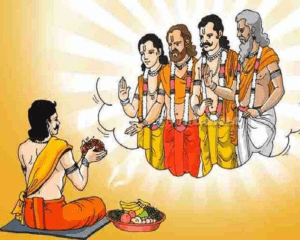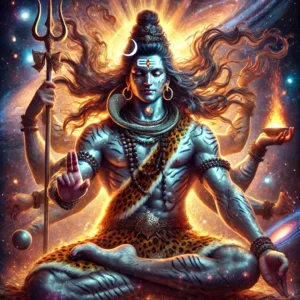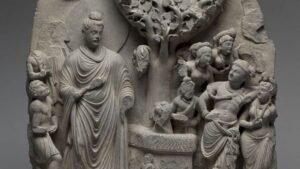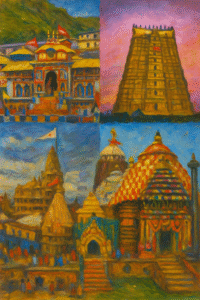
Angkor Wat: Symbol of Khmer Greatness
- The crown jewel of Cambodia’s ancient Khmer Empire, stands as one of the most iconic and awe-inspiring religious monuments in the world.
- Originally constructed in the early 12th century as a Hindu temple dedicated to the god Vishnu, Angkor Wat later transitioned into a Buddhist site, reflecting the region’s religious and cultural evolution.
- Spanning over 400 acres, it is the largest religious monument on Earth, showcasing architectural brilliance, historical depth, and cultural significance.
- This article delves deeply into the history, architecture, symbolism, and ongoing influence of Angkor Wat.
Historical Context of Angkor Wat
Origins and Construction
Angkor Wat was built during the reign of King Suryavarman II (1113-1150 CE), a ruler of the Khmer Empire. The temple was originally designed to serve as the king’s state temple and capital city, symbolizing both his political and divine authority. The name “Angkor Wat” translates to “City of Temples” or “Temple City” in Khmer, derived from the Sanskrit words “nagara” (city) and “vat” (temple).
The construction of Angkor Wat is believed to have taken approximately 30 years. The temple was meticulously constructed using sandstone blocks, which were transported from quarries located over 50 kilometers away. Each block was cut, shaped, and positioned with incredible precision, creating one of the most enduring monuments in human history.
Khmer Empire: A Flourishing Civilization
During its zenith in the 11th and 12th centuries, the Khmer Empire was one of Southeast Asia’s most powerful civilizations, with vast territories extending across modern-day Cambodia, Thailand, Laos, and Vietnam. Angkor Wat was the center of this empire, serving not only as a religious monument but also as a symbol of political power, architectural sophistication, and technological innovation.
The Khmer rulers were devoutly religious, initially adhering to Hinduism before transitioning to Mahayana and then Theravada Buddhism in later centuries. This evolution in religious thought is mirrored in Angkor Wat’s design and subsequent modifications.
Architectural Marvels of Angkor Wat
The Layout and Design
Angkor Wat is designed to represent Mount Meru, the sacred center of the universe in Hindu and Buddhist cosmology. Its central tower rises to a height of 65 meters (213 feet), symbolizing the mythological peak of Mount Meru, while the surrounding towers and walls represent the lower mountain ranges and oceans.
The temple is surrounded by a vast rectangular moat that spans 1.5 kilometers by 1.3 kilometers (0.9 miles by 0.8 miles) and is 190 meters (620 feet) wide. This moat not only serves a symbolic purpose, representing the cosmic ocean, but also plays a practical role in stabilizing the foundation of the structure.
The overall layout is based on a strict grid system, with the temple oriented to the west, a unique feature since most Hindu temples face east. This orientation towards the setting sun is often interpreted as a symbolic connection to Vishnu, who is associated with the west, or as a reflection of its function as a funerary temple for King Suryavarman II.
Temple Features: Gopuras, Galleries, and Bas-Reliefs
- Gopuras (Entrance Towers): The main entrance to Angkor Wat is through a grand western gate, flanked by two smaller towers. These gopuras lead visitors to the grand causeway, a 350-meter long path leading to the temple’s central sanctuary.
- Galleries: The temple is composed of three concentric rectangular galleries, each raised above the next. These galleries represent ascending levels of spiritual and physical closeness to the divine. The central gallery houses five towers, with the central spire being the tallest, marking the innermost sanctuary where the most sacred religious rituals were conducted.
- Bas-Reliefs: One of the most breathtaking features of Angkor Wat is its extensive bas-relief carvings that adorn the walls. Covering an astonishing 1,200 square meters, these detailed carvings depict scenes from Hindu mythology, including the famous “Churning of the Ocean of Milk,” which represents the struggle between gods (devas) and demons (asuras) to obtain the elixir of immortality. Other scenes depict the epic battles of the Ramayana and the Mahabharata, illustrating the temple’s rich religious context.
Engineering and Construction Techniques
The sheer scale and precision of Angkor Wat’s construction have long fascinated historians and engineers. The temple’s construction involved advanced engineering techniques that remain subjects of study today. The sandstone blocks used to build the temple were sourced from the Kulen Hills, over 50 kilometers away, and were transported to the site by a combination of rafts and waterways.
The blocks were held together using mortise and tenon joints rather than mortar, with a precise method of fitting stones so tightly that they still hold after almost 900 years. The temple’s durability is also enhanced by its sophisticated drainage system, designed to protect the structure during the monsoon seasons, directing water away from its foundations.
Symbolism and Religious Significance
Hindu Symbolism
Angkor Wat’s original design is deeply rooted in Hindu cosmology. The central tower of the temple represents Mount Meru, the home of the gods in Hindu mythology, while the surrounding towers and moat symbolize the concentric mountain ranges and cosmic ocean.
The temple’s extensive bas-reliefs are primarily devoted to stories from the two great Hindu epics, the Ramayana and the Mahabharata. These stories not only convey religious and moral teachings but also reflect the Khmer rulers’ attempts to establish a divine connection to the gods, particularly Vishnu, with whom King Suryavarman II is believed to have closely identified.
The Transition to Buddhism
By the late 12th century, Angkor Wat began to shift from a Hindu to a Buddhist site as the Khmer Empire embraced Mahayana Buddhism. Under King Jayavarman VII, who was a devout Buddhist, many of the Hindu elements were modified or replaced with Buddhist symbols. Today, Angkor Wat remains an active religious site, with Theravada Buddhism being the dominant faith practiced within its walls.
Angkor Wat in Modern Times
Rediscovery and Restoration
Angkor Wat was largely abandoned after the fall of the Khmer Empire in the 15th century, gradually being consumed by the surrounding jungle. However, unlike many other Angkorian temples, Angkor Wat was never completely abandoned, as it continued to be maintained by Buddhist monks.
In the mid-19th century, French explorer Henri Mouhot brought Angkor Wat to the attention of the Western world, and since then, extensive efforts have been made to restore and preserve the site. The temple has survived natural disasters, political turmoil, and looting, though it remains vulnerable to the impacts of tourism and environmental degradation.
Angkor Wat and Cambodian Identity
Angkor Wat is a source of immense national pride for Cambodians and is featured on the country’s flag. The temple is a symbol of the enduring strength and resilience of Cambodia’s cultural heritage, representing the glory of the Khmer Empire and the spiritual devotion of its people.
The Role of Angkor Wat in Global Tourism
Angkor Wat attracts millions of visitors each year, making it one of the most visited tourist sites in Southeast Asia. Its inclusion on UNESCO’s World Heritage list in 1992 has contributed to its growing global recognition, though it also presents challenges in terms of preservation and sustainable tourism.
Recent conservation efforts focus on protecting Angkor Wat from the wear and tear caused by tourism, environmental changes, and the encroaching jungle. Authorities have implemented strict regulations to balance the needs of preservation with the economic benefits tourism brings to Cambodia.
Angkor Wat’s Enduring Legacy
Angkor Wat is more than just an ancient monument; it is a symbol of human ingenuity, religious devotion, and the complex history of Southeast Asia. Its intricate architecture, vast scale, and rich history continue to captivate scholars, historians, and tourists alike. As both a historical wonder and a living religious site, Angkor Wat remains a vital link to Cambodia’s past and a testament to the enduring legacy of the Khmer Empire.






